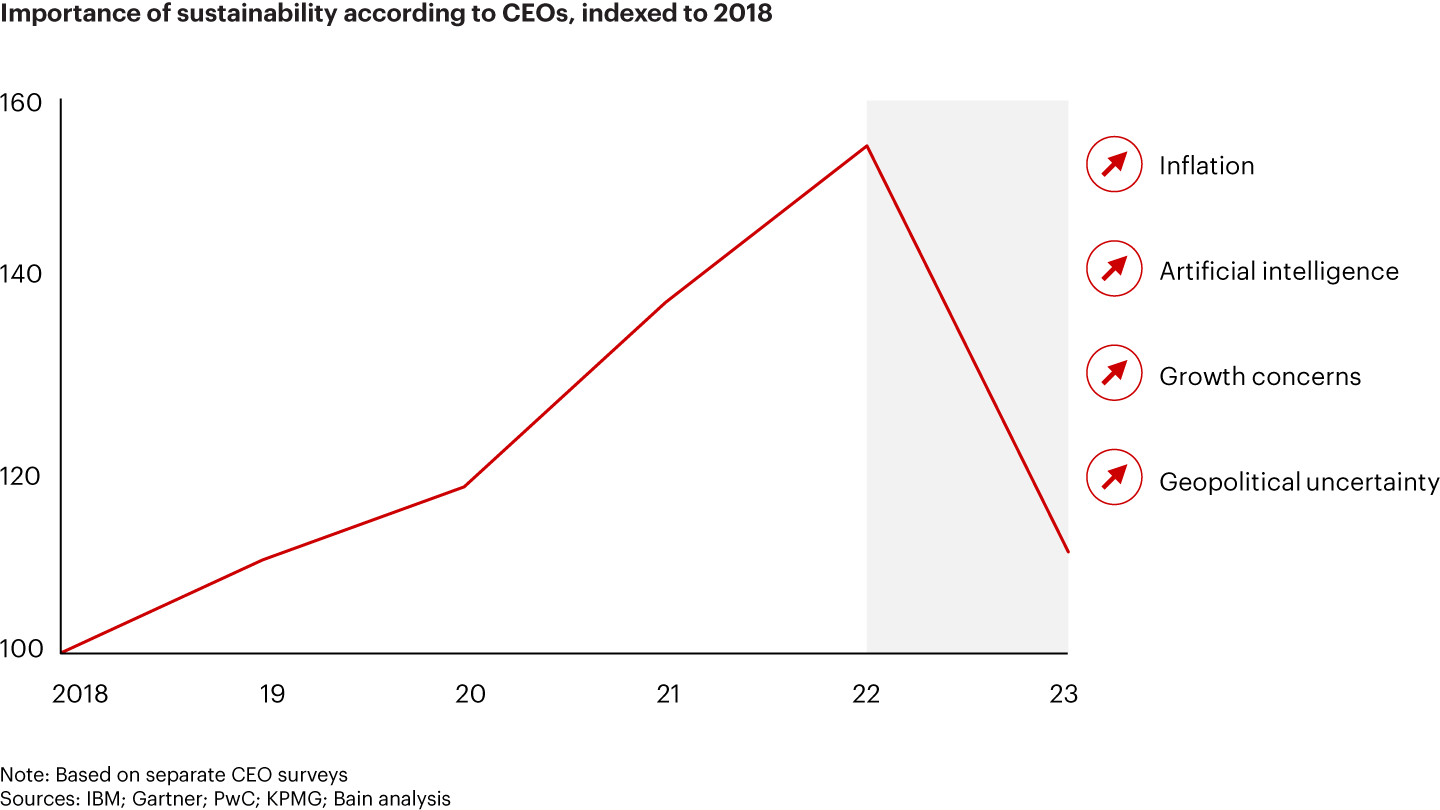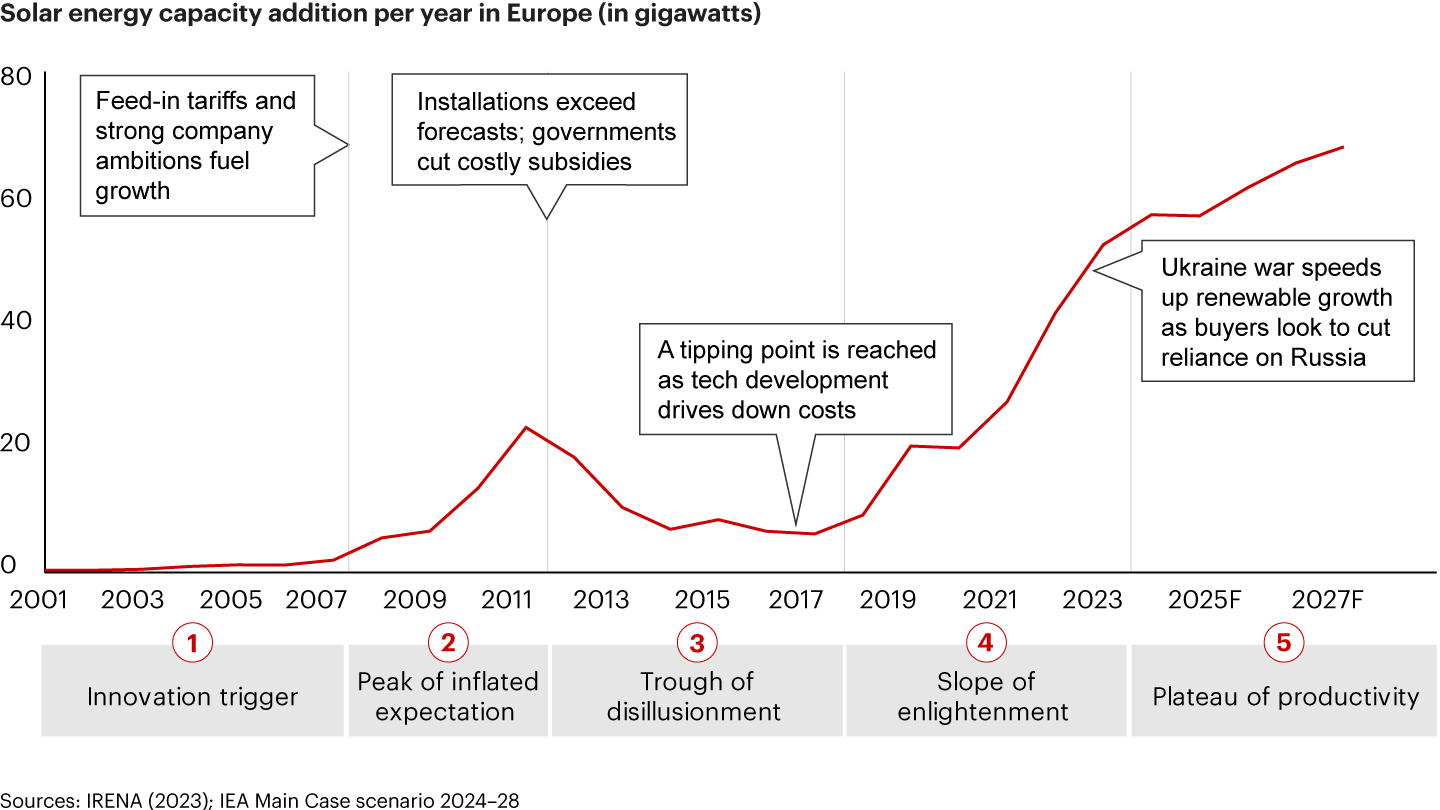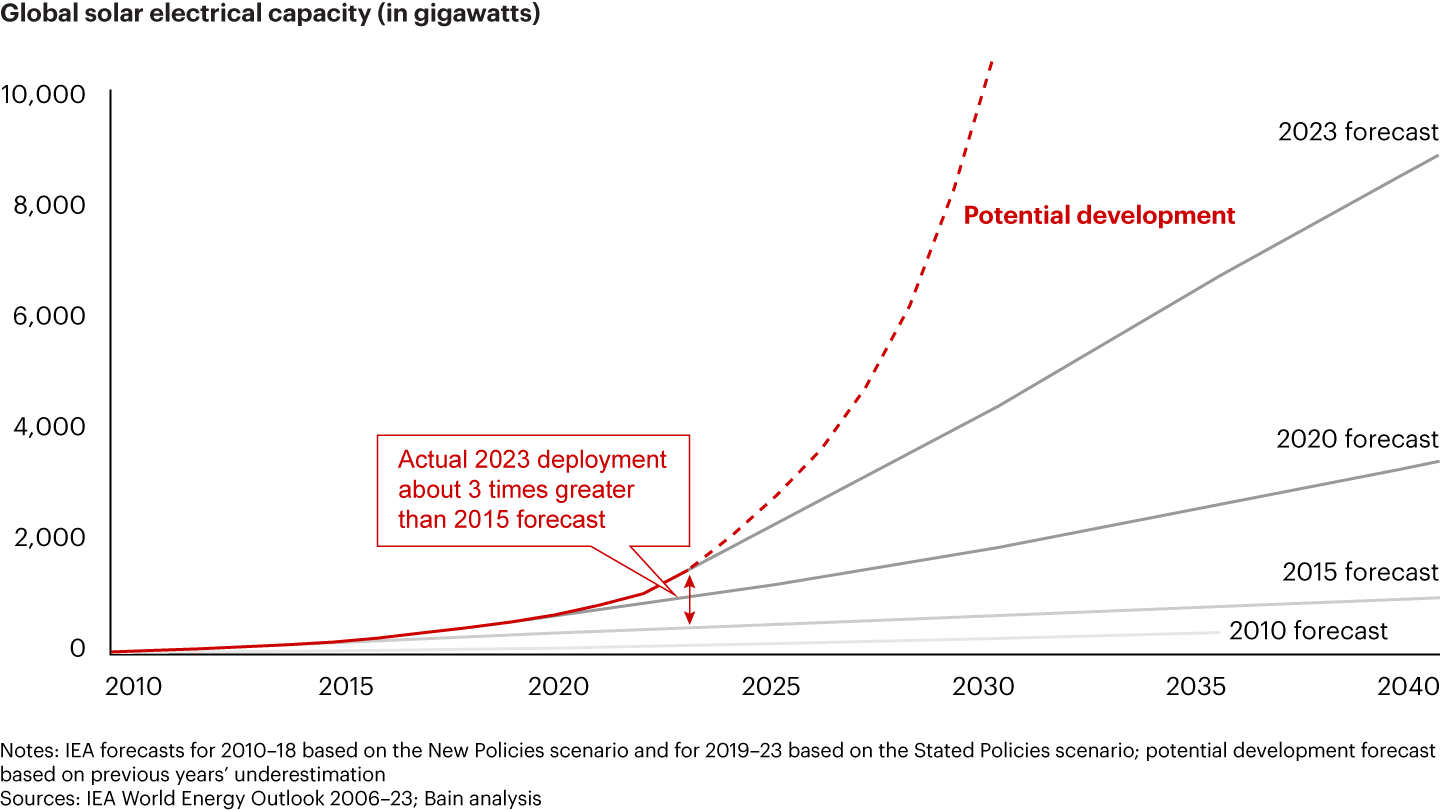The Visionary CEO’s Guide to Sustainability

At a Glance
- Inflation, AI, and geopolitics are in the spotlight, but Bain research shows that CEOs and consumers still value sustainability.
- Sooner than expected, a mix of new technologies, consumer behavior, and smart policy will create opportunities.
- Asking and answering four questions can help CEOs set the right ambition and identify a practical, effective path forward.
This article is part of Bain's 2024 CEO Sustainability Guide
If 2021 and 2022 were years of near boundless excitement, bold commitments, and mobilization, the past 12 months brought a hefty dose of reality about sustainability as CEOs juggle an increasing number of sweeping, systemic challenges. Global surveys reveal a sharp decline in CEOs’ prioritization of sustainability relative to other topics. Disruptive technology, growth, inflation, and geopolitical uncertainty have taken the top spots on their agendas (see Figure 1).
Even as these other concerns rise, Bain & Company research shows that sustainability remains important to executives and consumers. Of nearly 19,000 consumers surveyed, roughly 60% are more concerned about climate change than they were two years ago, often due to personal experience of extreme weather. Among B2B buyers, 36% say they would leave a supplier that didn’t meet their sustainability expectations.
They are right to care. A temperature increase of 2 degrees Celsius would have devastating consequences not only for mankind, nature, and biodiversity, but for the economy as well. The International Monetary Fund estimates that the cost of capital could rise by more than 1%. That alone could cut $6 trillion from the value of the S&P 500.

Sustainability still matters, but companies are struggling to meet their existing commitments. Of the companies disclosing their progress via CDP, 30% are well behind on their Scope 1 and 2 emissions reduction goals, and almost half are behind on Scope 3. Many companies are reassessing, adjusting, and, in some cases, retracting their climate commitments. Some are simply missing the mark. In March 2024, 29% of companies in the Science Based Targets initiative’s Business Ambition for 1.5C campaign were removed for noncompliance.
This is unfolding against a backdrop of heightened regulatory demands, as policymakers increasingly require public companies to disclose material mitigation activities and sustainability targets. Noncompliance risks penalties and reputational harm—both to companies and to their leaders individually—pressuring executives to either double down or step back.
A familiar cycle
The transition to a more sustainable world is following a familiar cycle (see Figure 2). These cycles of transformation typically start with a trigger—a technological breakthrough, a sudden societal change, or a regulatory impulse.
A “hype” phase of excitement, hope, and frenzied activity follows this trigger, with behavior often accelerated by generous policy incentives. When sky-high expectations are not quickly met, or governments pull back prematurely, sentiment falls into the “trough of disillusionment,” a realization that the transformation will not be as quick or as easy as expected. At this point, it’s common for stakeholders to rethink their approach.
Many sustainability efforts are currently in this trough.

The shape and pace of this curve are influenced by the interplay of three forces discussed in last year’s CEO guide to sustainability: technology, consumer/customer behavior, and policy. As technology advances, companies improve efficiency and lower costs. As costs decline, adoption by customers and consumers picks up, growth accelerates, and a tipping point is reached. Before that critical threshold, government policies such as subsidies and regulation can provide a bridge of support as companies build knowledge and experience.
The history of the electric vehicle industry in Germany and Norway illustrates how policy can shape this trajectory. As EV manufacturers have moved along the technology experience curve over the last six years, battery costs have dropped by one-third and are projected to fall another 25% by 2030.
Through its policies, Norway has steadily supported EVs and consumer adoption. As a result, sales there have continued to grow. In Germany, by contrast, direct subsidies for EV purchases were significantly reduced at the beginning of 2023 and cut altogether at the end of the year. EV sales promptly dropped and remain below 2023 levels. Germany’s government cut support too early, before the cost of technology could reach the point at which the market would be self-sustaining.
This dynamic takes time to play out. CEOs should take a long-term view and not overreact to short-term trends. The trajectories of early sustainable technologies like solar are instructive (see Figure 3). Pushed by technological breakthroughs and government subsidies, Europe’s solar industry grew dramatically from 2000 to 2011. Then, as governments cut subsidies faster than the cost benefits from technological breakthroughs could be realized, the market cooled significantly. But by 2017, solar had reached its tipping point. Panel producers had enough experience and costs had declined to the point where mainstream consumers and energy companies were buying.
Companies and CEOs that stayed the course put themselves in position to benefit from the now-clear business case for solar. Today, installations are booming across Europe and much of the world.

As cost and adoption continue their dynamic interaction, many sustainable technologies are likely to reach their tipping point more quickly than expected. Forecasts for the development of solar and wind capacity, for example, have consistently underestimated market growth. Actual 2023 solar capacity was more than three times 2015 forecasts (see Figure 4). If this underforecasting continues, deployment may be even quicker than currently expected.

As business leaders navigate these challenges, visionary pragmatism is needed more than ever. Based on conversations and work with hundreds of companies and executives, we have identified four key questions that will help leaders in any industry or location set their ambition and begin to chart the path ahead.
1. How will global sustainability transitions shape the future business landscape?
Dramatic shifts are underway in our energy supply, our global food system, the financing of sustainability, and materials supply and consumption. These transitions bring risks and opportunities that will play out over horizons far beyond the typical two- to three-year planning period. There will be new profit pools, supply chain disruptions, and scarcity. Political and technological developments, such as AI’s huge energy demand, will create disruption.
To prepare, companies must first envision the future and develop scenarios and future-back strategies that ensure they are ready to make the right choices. This may include quickly securing a reliable supply of raw material, making foundational investments in sustainability, or evaluating the vulnerabilities of a fixed asset base.
One example: In response to increasing regulation and decarbonization targets for high-carbon-emitting steel production, steel companies are building green steel production in phases. They are gradually replacing existing blast furnaces with hydrogen-based direct reduction and green-electricity-powered arc furnaces, thereby developing technological and sustainable selling expertise while protecting their license to operate as regulation accelerates.
2. What are our critical priorities, and how fast must we move?
Moving from ambitious commitments to practical delivery is hard. Focus on truly material topics—those that are critical for the business and where it is possible to make meaningful change—is essential. Some companies are rethinking and restating sustainability targets, and more are asking tough questions. It will be important to stay focused on sustainability and prepare to accelerate in order to gain competitive advantage as scenarios change.
One example: a machinery company. One of the first to set ambitious environmental, social, and governance targets, the company realizes it is spread too thin and that some of its commitments are not directly tied to competitive advantage or business value. Others have had limited impact. The company refocuses on a smaller number of meaningful changes, setting ambitious Scope 1 and 2 and upstream Scope 3 decarbonization goals. The company also zeroes in on one additional area that matters most to it and its customers: circularity.
3. How can we build a business case for sustainability?
High costs and uncertain return on investment are the two impediments to developing sustainability programs most frequently mentioned by executives. To build a business case for sustainability, focus on multiple aspects: cost reduction from more efficient raw materials and energy consumption, commercial opportunities such as new customers, price premiums, and avoiding downside risks. Implementing changes with positive ROI first, companies can gain the momentum needed to tackle more complex ones.
One example: In the chemical industry, companies will need to make substantial capital investments in decarbonization. To offset these costs, one company is exploring commercial opportunities in sustainable plastics such as low-carbon-intensity polyethylene. It has identified several suitable applications and end markets that could help it gain share, thereby building a clear business case for the investment.
4. What actions should we take with external stakeholders?
Sustainability issues are complex and systemic. Companies can’t go it alone. They must work up and down their supply chain to develop end-to-end solutions. Industry coalitions can help signal shared intent and foster precompetitive collaboration. Executives must work proactively to shape the policy landscape and build relationships in the public and nonprofit sectors.
One example: a hypothetical textile company that faces shortages in recycled inputs such as rPET due to inefficient and inconsistent collection methods and competing demand from other industries. It looks to develop partnerships across the value chain with fiber and PET recyclers, collaborate precompetitively with other textile companies, and create partnerships with consumer products companies facing similar shortages. Such broad coalitions might help influence country-level recycling regulations and boost supply.
Helping executives answer these four questions is the aim of this CEO guide. We offer new research on B2B customers and end consumers—what they want, how willing they are to pay for sustainability, and how to influence their behavior. We dive deeply into challenging transitions, including energy, AI, and food systems. And we speak to a CFO who is pioneering a new financial model for sustainability. We hope you find both inspiration and practical ideas to take to your teams and organizations.



